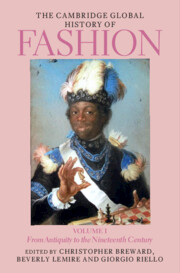Book contents
- The Cambridge Global History of Fashion
- The Cambridge Global History of Fashion
- The Cambridge Global History of Fashion
- Copyright page
- Contents for Volume I
- Figures for Volume I
- Maps for Volume I
- Table for Volume I
- Contributors for Volume I
- Preface
- 1 Global History in the History of Fashion
- Part I Multiple Origins of Fashion
- Part II Early Modern Global Entanglements
- 7 Magnificence at the Royal Courts in the Islamic World
- 8 Early Modern Fashion Cities
- 9 Fashioning Possibilities
- 10 Fashion Beyond Clothing
- 11 Fashion and the Maritime Empires
- 12 Garments of Servitude, Fabrics of Freedom
- Part III Many Worlds of Fashion
- Index
- References
12 - Garments of Servitude, Fabrics of Freedom
Dress of Enslaved and Free Diaspora African Communities in the Mid-Atlantic, c. 1700–1840
from Part II - Early Modern Global Entanglements
Published online by Cambridge University Press: 04 August 2023
- The Cambridge Global History of Fashion
- The Cambridge Global History of Fashion
- The Cambridge Global History of Fashion
- Copyright page
- Contents for Volume I
- Figures for Volume I
- Maps for Volume I
- Table for Volume I
- Contributors for Volume I
- Preface
- 1 Global History in the History of Fashion
- Part I Multiple Origins of Fashion
- Part II Early Modern Global Entanglements
- 7 Magnificence at the Royal Courts in the Islamic World
- 8 Early Modern Fashion Cities
- 9 Fashioning Possibilities
- 10 Fashion Beyond Clothing
- 11 Fashion and the Maritime Empires
- 12 Garments of Servitude, Fabrics of Freedom
- Part III Many Worlds of Fashion
- Index
- References
Summary
The Atlantic Basin was the centre of vibrant commerce that included vast quantities of essential commodities such as textiles and clothing that influenced dress and consumer goods consumption throughout the region. The dress customs of the Atlantic world were characterized by enormous variety and complexities born out of commingling and migration of diverse groups of people. This blending was also part of a globalizing world in which capitalism and transformation in consumer culture gave rise to new identities and styles. Atlantic dress depicted differentiation and overlapping cultural influences that were by-products of local and global trade systems connecting people across several colonial empires. In the Atlantic Basin, for instance, many colonies relied on large imports of Indian cottons that were also traded in West and Central Africa in exchange for slaves needed to provide labour in plantation zones of the Americas. Consequently, the Atlantic world was influenced by wider intercontinental patterns and a burgeoning global economy.
- Type
- Chapter
- Information
- The Cambridge Global History of FashionFrom Antiquity to the Nineteenth Century, pp. 399 - 442Publisher: Cambridge University PressPrint publication year: 2023



